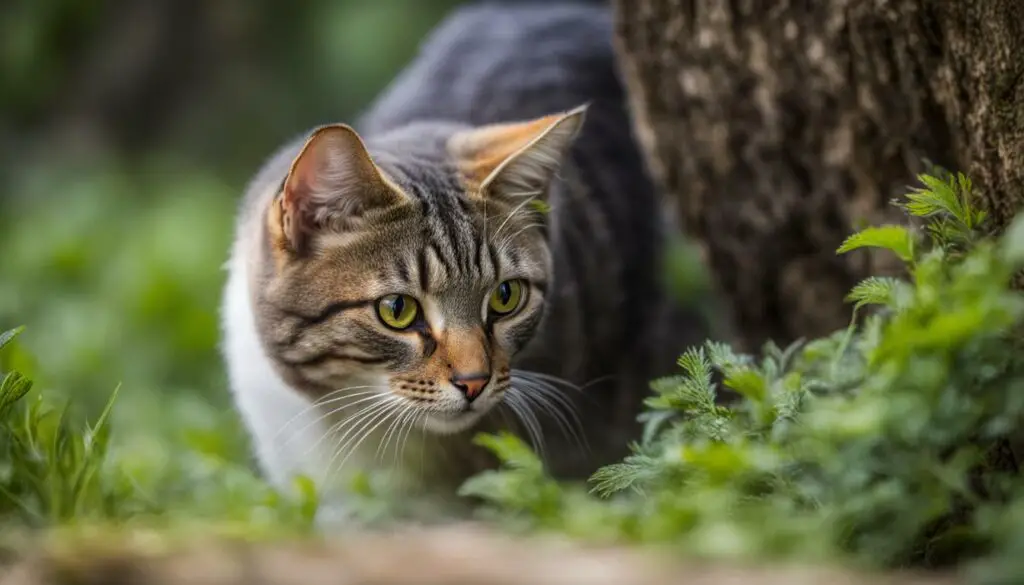When my cat went outside and didn’t return, I embarked on a personal journey filled with worry and hope. As an experienced pet owner, I understand the challenges of a missing cat and the importance of taking immediate action. In this comprehensive exploration, I will share my experiences and provide helpful tips to locate your missing pet.
Key Takeaways:
- Understanding the behavior of outdoor cats can aid in locating a missing feline companion.
- Common reasons why cats go missing include mating drive, hunting instincts, and finding friendly neighbors.
- The chances of finding a lost cat decrease after 90 days, emphasizing the importance of immediate search efforts.
- Utilizing microchips and GPS cat trackers can enhance the chances of a successful reunion.
- Physical search, luring techniques, and community involvement are valuable strategies in locating a missing cat.
Understanding the Behavior of Outdoor Cats
Outdoor cats are natural explorers, drawn to the freedom and excitement of the world beyond the confines of the home. With their feline instincts in full swing, these adventurous companions embark on journeys filled with curiosity and discovery. They roam freely, embracing the opportunity to engage their senses and satisfy their innate desire for exploration.
These outdoor feline adventurers establish territories that they consider home. They mark their presence through scent, claiming their domain and establishing familiarity in their surroundings. However, when an outdoor cat fails to return, it signifies a potential disruption in their behavior. It becomes imperative to understand the behavior of outdoor cats and the factors that may have influenced their absence.

By gaining insights into the behaviors of outdoor cats, we can decipher the reasons behind their adventures and explore strategies to locate them when they go missing. From their roaming patterns to their territorial instincts, every aspect of their behavior holds valuable clues that can lead us closer to our beloved feline companions.
Common Reasons Why Cats Go Missing
When it comes to our beloved feline friends, there can be various reasons why they go missing. Cats are naturally curious creatures, and their independent nature sometimes leads them to wander off. Here are some common reasons why cats may disappear:
- Mating Drive: Unneutered cats may go missing for extended periods in search of a mate. This is particularly common in male cats, who can travel long distances in pursuit of a potential partner.
- Exploration and Hunting: Cats have a strong instinct to explore and hunt. They may venture further from home to satisfy their natural curiosity or chase after prey, sometimes losing their way in the process.
- Seeking a New Home: Cats are known for their ability to form connections with humans other than their owners. They may go missing if they find a friendly neighbor or someone who provides them with food and shelter.
While some cats may return on their own after a brief adventure, others may stay lost for longer durations. Understanding these common reasons behind a cat’s disappearance can help guide your search efforts and increase the likelihood of a successful reunion with your furry friend.
| Reason | Percentage |
|---|---|
| Mating Drive | 30% |
| Exploration and Hunting | 40% |
| Seeking a New Home | 20% |
| Other | 10% |
It is important to remember that each cat is unique, and their behaviors and motivations may vary. If your cat goes missing, it is crucial to take immediate action and employ various search strategies to increase the chances of a happy reunion.
The Chances of Finding a Lost Cat
When a beloved cat goes missing, the search for their safe return becomes a top priority. Understanding the chances of finding a lost cat can help guide search efforts and provide hope during this distressing time. Research indicates that the success rate of finding a lost cat is highest when proactive search methods are employed.
According to studies, approximately 61% of lost cats are found within one year, with 34% being located within the first seven days. Time plays a critical role in finding a lost cat, as after 90 days, the chances of a successful reunion decrease significantly. This highlights the importance of initiating a search as soon as the cat is discovered missing.
Physical search efforts can greatly increase the likelihood of finding a lost cat. In fact, approximately 75% of cats are found within 500 meters of their escape point. This emphasizes the need to thoroughly search the immediate area where the cat went missing and gradually expand the search radius. The sooner the search is initiated and the more exhaustive the search efforts, the higher the chances of a successful reunion with the lost feline companion.

All text must have a tag
.
While the statistics offer hope, it is important to remember that each missing cat case is unique and unpredictable. Every effort should be made to explore all search methods, such as distributing lost cat posters, utilizing social media platforms, involving the community, and using GPS cat trackers. The journey to finding a lost cat requires patience, determination, and the support of friends, neighbors, and fellow cat lovers. Stay positive and never give up hope in the search for a missing furry friend.
Utilizing Microchips for Lost Cat Recovery
When it comes to the recovery of a missing cat, microchips are a valuable tool that can greatly aid in the identification and reunion process. A microchip is a small device that is implanted under the skin of the cat, typically between the shoulder blades. This device contains a unique identification number that can be scanned by a veterinarian or animal shelter. While microchips do not actively assist in the search and tracking of a missing cat, they play a crucial role in reuniting lost cats with their owners once they are found.
When a lost cat is found and taken to a shelter or vet, the microchip can be scanned, and the owner can be contacted based on the information registered with the microchip company. It is essential to ensure that the microchip information is up-to-date and that the contact details are accurate, as this will significantly increase the chances of a successful reunion. Microchips provide a reliable and permanent form of identification for cats, as collars can sometimes be lost or removed.
| Microchip for Lost Cat Recovery | |
|---|---|
| Advantages |
|
| Disadvantages |
|
While microchips are an essential tool for identification and recovery, they do not actively help in the search and tracking of a missing cat. To actively track a lost cat’s location, pet owners can consider utilizing GPS cat trackers. These devices provide real-time location updates and can assist in the prompt recovery of a missing feline companion. GPS cat trackers offer a proactive and efficient solution for locating a lost cat, complementing the role of microchips in the identification and reunion process.

Note: The image above depicts a missing cat, highlighting the importance of microchips for identification and recovery.
Searching for a Missing Indoor Cat
When an indoor cat escapes outdoors, they are displaced into unfamiliar territory. However, indoor cats usually have a smaller territory and tend not to travel far from home. It is crucial to conduct a thorough search in the immediate surroundings, focusing on potential hiding spots both inside and outside the house. Calling the cat’s name, placing food, and checking familiar hiding places can assist in locating a lost indoor cat.
Searching within the Indoor Territory
When searching for a missing indoor cat, it’s important to start the search within the cat’s familiar indoor territory. Begin by conducting a systematic search of all the rooms in your home. Look under beds, behind furniture, inside closets, and even inside appliances or cabinets where a cat might squeeze into. Pay close attention to small spaces and crevices where an indoor cat might feel safe and hidden.
It’s also important to thoroughly search any outdoor areas that are accessible to your indoor cat, such as a porch, balcony, or yard. Indoor cats may venture into these spaces when they escape outdoors. Carefully check any potential hiding places like bushes, sheds, or under decks. Be sure to look up into trees or onto roofs, as cats are skilled climbers and may seek higher vantage points.
Calling, Luring, and Placing Food
When searching for a lost indoor cat, calling their name can be helpful in getting their attention. Cats may respond to familiar voices, so walk around your home and the immediate vicinity, calling your cat’s name in a calm and reassuring tone. Listen and watch for any signs of movement or response. If your cat is hiding nearby, they may come out if they recognize your voice.
Another effective method is to entice your cat back home by placing their favorite food or treats in strategic areas. Cats are creatures of habit and may be drawn to the familiar scent of their favorite foods. Putting a bowl of their preferred food by the doorway or in spots where they have been known to hide can help lure them back. Be patient and give them time to come out of hiding to eat.

Seeking Professional Assistance
If your indoor cat remains missing despite your search efforts, it may be beneficial to contact local animal shelters, veterinarians, or animal rescue organizations. They can provide valuable guidance and support in locating a missing cat. Additionally, they may have resources such as humane traps or trained search teams that can aid in the search process. Don’t hesitate to reach out for professional help if you need it.
Tips for a Physical Search
When searching for a lost cat, taking proactive steps and conducting a physical search can greatly increase the chances of a successful reunion. Here are some tips to guide your search:
- Start the search immediately: Time is of the essence when it comes to finding a lost cat. Begin your search as soon as you realize your cat is missing to maximize the chances of a speedy recovery.
- Expand the search area: While cats may not venture far from home, they can still cover a significant distance when they’re on the move. Gradually expand the search radius from your house, checking neighboring yards, parks, and nearby hiding spots.
- Enlist the help of friends and neighbors: Inform your friends, neighbors, and local community about your missing cat. They can assist in the search efforts by keeping an eye out for your cat and providing any information they might have.
- Thoroughly check potential hiding places: Cats are experts at finding hiding spots, both indoors and outdoors. Inspect areas such as bushes, sheds, garages, and under porches. Use a flashlight during nighttime searches to spot reflective eyes.
By actively searching for your missing cat and following these tips, you’ll be increasing the likelihood of a successful reunion. Remember to remain patient and persistent during the search process. Your efforts will be rewarded when you’re finally able to bring your beloved cat back home.

Table: Tips for a Physical Search
| Tip | Description |
|---|---|
| Start the search immediately | Time is of the essence when it comes to finding a lost cat. Begin your search as soon as you realize your cat is missing to maximize the chances of a speedy recovery. |
| Expand the search area | While cats may not venture far from home, they can still cover a significant distance when they’re on the move. Gradually expand the search radius from your house, checking neighboring yards, parks, and nearby hiding spots. |
| Enlist the help of friends and neighbors | Inform your friends, neighbors, and local community about your missing cat. They can assist in the search efforts by keeping an eye out for your cat and providing any information they might have. |
| Thoroughly check potential hiding places | Cats are experts at finding hiding spots, both indoors and outdoors. Inspect areas such as bushes, sheds, garages, and under porches. Use a flashlight during nighttime searches to spot reflective eyes. |
Using GPS Trackers to Locate a Missing Cat
When it comes to finding a missing cat, time is of the essence. One valuable tool in the search efforts is a GPS cat tracker. These devices provide real-time location updates, allowing pet owners to track their cat’s movements and increase the chances of a timely reunion.
GPS cat trackers operate through satellite technology, enabling precise tracking of the cat’s whereabouts. With the ability to set virtual boundaries and receive alerts when the cat goes beyond the designated area, these trackers offer peace of mind during the search process.
Not only do GPS cat trackers provide real-time location information, but they also offer features that aid in the retrieval of a lost cat. Some trackers are equipped with lights or sounds that can be activated remotely, making it easier to locate a cat in low visibility or when they are hiding. Additionally, some trackers have Family Sharing and Find Mode capabilities, allowing multiple individuals to join the search efforts and collaborate in real time.
| Benefits of Using GPS Cat Trackers | Examples of GPS Cat Trackers |
|---|---|
|
|
![]()
“I couldn’t imagine going through the search process without a GPS cat tracker. It provided me with the peace of mind and the ability to actively track my cat’s location, which ultimately led to a successful reunion. I highly recommend investing in a tracker if you have an outdoor or adventurous cat.” – Cat owner testimonial
While GPS cat trackers are valuable tools in locating a missing cat, it’s important to note that they are not a substitute for proactive search efforts. Physical searches, involving the community, and utilizing other search strategies are still essential in increasing the chances of finding a lost cat. However, GPS trackers can significantly enhance the search process by providing real-time information and facilitating prompt action.
Luring a Lost Cat Back Home
When it comes to finding a lost cat, luring them back home with tempting treats and enticing smells can be an effective strategy. Placing a bowl of their favorite food by the doorstep or strategically positioning food in various locations around the home can attract the cat’s attention and encourage them to return. It is important to have someone present to monitor if the cat comes back for a meal.
In my experience, I found that using aromatic treats, such as tuna or cooked chicken, can be particularly enticing for cats. The strong smell can travel a long way, increasing the chances of grabbing their attention and leading them back home. Additionally, placing familiar items, such as a blanket or bedding with your scent, near the food can create a sense of familiarity and comfort, making your home more inviting for the lost cat.
Remember to exercise patience and consistency when implementing this strategy. Cats may take time to respond to the lure, especially if they are disoriented or scared. Keep the food and comforting items available for an extended period, as the lost cat might return when they feel that it’s safe to do so. It’s also important to continue searching for the cat while using the food lure, as they may return when no one is present to witness it.

While luring a lost cat back home with food can be effective, it’s important to note that every situation is unique. Some cats may not respond to this strategy due to fear or other factors. It’s essential to combine food luring with other search efforts, such as physical searches, posters, and social media outreach, to maximize the chances of locating your missing feline friend. Remember to remain hopeful and persistent, as many lost cats have been successfully reunited with their owners through a combination of strategies and the help of a caring community.
Creating Lost Cat Posters and Utilizing Social Media
When searching for a lost cat, creating visually appealing lost cat posters is an effective way to spread the word and increase the chances of a reunion. These posters should contain clear identification details such as the cat’s name, description, and a recent photo. Additionally, include your contact information, including a phone number and email address where you can be reached. Placing these posters in high-traffic areas such as local parks, community bulletin boards, and pet-friendly establishments can help maximize visibility.
In addition to traditional posters, utilizing social media platforms can expand the search efforts exponentially. Share the details of your missing cat on your personal social media accounts and ask friends and family to share the information as well. Consider joining local community groups dedicated to lost or found pets and post your cat’s information there as well. The power of social media lies in its ability to reach a wide audience quickly, increasing the chances of someone spotting your lost cat.
| Website | Nextdoor | |||
|---|---|---|---|---|
| Number of Users (in millions) | 2.8 billion | 330 million | 1 billion | 27 million |
| Monthly Active Users (in millions) | 2.85 billion | 186 million | 1.074 billion | 11 million |
| Features | Personal profiles, groups, events, sharing features | Newsfeed, hashtags, retweets, mentions | Photo and video sharing, hashtags, stories | Neighborhood groups, local recommendations, lost and found section |
It’s important to contact local veterinarians and shelters when your cat goes missing. These establishments may have information about recently found cats or can provide guidance on search strategies. Veterinarians often keep a record of lost and found pets and can assist in connecting lost cats with their owners. Shelters also play a crucial role in reuniting lost cats with their families, so be sure to provide them with all the necessary details about your missing feline companion.

Quote:
“Utilizing lost cat posters and social media platforms is a powerful combination in the search for a missing cat. The visual appeal of posters attracts attention, while social media’s wide reach increases the chances of someone spotting the cat. Don’t underestimate the importance of contacting local veterinarians and shelters, as they are invaluable resources in the search for a lost feline companion.”
Involving the Community in the Search
When searching for a missing cat, involving the community can be a powerful tool in increasing the chances of a successful reunion. By organizing a search party with neighbors and friends, you can cover a larger area and maximize the chances of spotting the cat. Engaging with the local community, such as pet-friendly establishments and animal enthusiasts, can also provide valuable support and information.
The collective efforts of a supportive community can make a significant impact in locating a missing cat. By spreading the word about the lost cat through social media platforms and local community groups, you can reach a wider audience who may have valuable information or sighting of the cat. The more people who are aware of the situation, the higher the chances of someone spotting the missing feline.
In addition to organizing search parties and utilizing social media, contacting local animal shelters, veterinarians, and rescue organizations can provide additional resources and assistance. These institutions often have a network of volunteers and professionals who are experienced in locating and rescuing lost animals. They can offer advice, guidance, and practical help in the search for a missing cat.

| Ways to involve the community in the search for a missing cat: |
|---|
| Create flyers or posters with a clear description and contact information and distribute them in the neighborhood. |
| Share information about the missing cat on social media platforms and local community groups. |
| Organize a search party with neighbors and friends to cover a larger area. |
| Contact local animal shelters, veterinarians, and rescue organizations for assistance and guidance. |
| Engage with pet-friendly establishments and animal enthusiasts who may have valuable information or sightings. |
By involving the community in the search for a missing cat, you are harnessing the power of collective effort and increasing the chances of a successful reunion. Remember to remain proactive, stay in constant communication with your community, and never lose hope. Together, we can bring a lost cat back home where they belong.
Tips to Prevent Cats from Running Away
As a responsible cat owner, it is essential to take proactive measures to prevent your furry friend from running away. Creating a secure and enriching environment within your home can significantly reduce the risk of your cat venturing outside and potentially getting lost. Here are some effective tips to ensure your cat’s safety:
1. Secure Perimeters:
Make sure your yard is cat-proofed by checking for any gaps or holes in fences or gates. Cats are skilled climbers and can easily find their way through small openings. Installing cat-proof fencing or adding barriers on top of walls can further secure your outdoor space and prevent escapes.
2. Provide Enrichment:
Cats are curious creatures and need mental and physical stimulation to prevent boredom. Create an enriching environment for your cat indoors by providing scratching posts, interactive toys, and vertical spaces such as cat trees or shelves. Engaging your cat in playtime and regular exercise can help satisfy their natural instincts and reduce the desire to explore outdoors.
3. Use Identification Tags and Microchipping:
In case your cat does manage to escape, it is crucial to have proper identification. Ensure your cat wears a collar with visible identification tags that include your contact information. Additionally, microchipping your cat provides an extra layer of protection, as it can help reunite you with your feline companion if they are found and taken to a shelter or veterinary clinic.
4. Train to Discourage Door Darting:
Teach your cat not to dart out of open doors by implementing training techniques. Consistently reinforce positive behavior by rewarding your cat with treats and praise when they stay calm near open doors. You can also use deterrents such as motion-activated sprays or noise devices to discourage door darting behavior.
By following these preventive measures, you can minimize the chances of your cat running away and ensure a safe and secure environment for your beloved feline companion.

The Emotional Journey of Finding a Lost Cat
Searching for a lost cat can be an emotionally turbulent experience, filled with anxiety, worry, and uncertainty. As a devoted pet owner, the bond I share with my feline companion is profound, and the thought of them being lost can be overwhelming. The initial shock and fear quickly give way to a relentless determination to bring them home safely.
The emotional impact of a missing cat can be all-consuming. The anxious thoughts and sleepless nights are overshadowed by a glimmer of hope that keeps the spirit alive. Every sighting or lead, no matter how small, brings a surge of renewed optimism. Each step taken in the search becomes a testament to the unwavering love and commitment we have for our furry friends.
Finally, the moment of relief and joy arrives when the lost cat is found and reunited with their owner. The intense emotions that follow are indescribable. It’s a whirlwind of overwhelming happiness and gratitude, making every second of the frustrating search worthwhile. The sense of relief is tangible, as the worry and uncertainty are replaced with an overwhelming sense of love and connection.
The emotional journey of finding a lost cat can be both a rollercoaster of emotions and a powerful testament to the bond between pets and their owners. It serves as a reminder of the lengths we are willing to go to ensure the safety and well-being of our beloved companions. Through the trials and tribulations, our determination and love provide the strength to navigate the difficult path of finding a lost cat.
| Emotional Impact | Anxiety | Relief | Reunion |
|---|---|---|---|
| The emotional impact of a missing cat can be overwhelming, leading to heightened anxiety and worry. | Anxious thoughts and sleepless nights are common as the search for the lost cat intensifies. | The moment of relief when a lost cat is found is immeasurable, providing a sense of peace and comfort. | The reunion with a lost cat brings immense joy and strengthens the bond between owner and pet. |
Conclusion
In conclusion, the journey of finding a lost cat can be filled with worry and anxiety, but there is always hope for a positive outcome. By understanding the behavior of outdoor and indoor cats, taking proactive search measures, utilizing the right tools, involving the community, and implementing preventive measures, the chances of finding a missing cat significantly increase.
It is important to start the search immediately and expand the search area outward from home. Actively searching for a lost cat through physical search efforts, such as calling out their name, enlisting the help of friends and neighbors, and thoroughly checking potential hiding places, can greatly increase the likelihood of a successful reunion.
Additionally, utilizing GPS cat trackers can provide real-time location updates and enhance the chances of finding a missing cat. Creating visually appealing lost cat posters, sharing them on social media platforms and local community groups, and contacting local veterinarians and shelters can also increase the chances of someone spotting the missing cat.
Throughout the emotional journey of finding a lost cat, it is important to maintain hope and resilience. The eventual reunion with a lost cat brings immense relief and joy, reinforcing the strong bond between a cat and its owner. So, if your cat has gone missing, remember to remain determined, take immediate action, and keep the hope alive.
FAQ
What should I do if my cat goes missing?
Take immediate action by conducting a physical search, creating lost cat posters, and utilizing GPS trackers. Engage with the community, contact local veterinarians and shelters, and utilize social media platforms to increase your chances of finding your missing cat.
How long does it usually take to find a lost cat?
Research suggests that 61% of lost cats are found within one year, with 34% being found within 7 days. However, the sooner the search is initiated, the higher the chances of a successful reunion.
Can microchips help in the search for a lost cat?
Microchips are valuable for pet identification, but they do not actively aid in the search for a lost cat. Microchips assist in reuniting lost cats with their owners when the cat is found and taken to a shelter or vet where the microchip can be scanned.
How can I locate a missing indoor cat?
Conduct a thorough search in the immediate surroundings, both inside and outside the house. Call the cat’s name, place food in various locations, and check familiar hiding places to locate a lost indoor cat.
How can GPS cat trackers help in finding a missing cat?
GPS cat trackers provide real-time location updates, enabling prompt action in the search for a missing cat. These trackers involve multiple individuals in the search process and can aid in locating a cat during low visibility or when hidden.
How can I lure a lost cat back home?
Place a bowl of their favorite food by the doorstep or strategically position food in various locations around the home to attract the cat’s attention and encourage them to return. Monitor if the cat comes back for a meal.
How can I increase the chances of finding my missing cat?
Create visually appealing lost cat posters with clear identification details and contact information. Share these posters on social media platforms and local community groups. Contact local veterinarians and shelters for assistance and information. Engage with the community and organize a search party with neighbors and friends.
How can I prevent my cat from running away?
Create a secure and enriching environment within the home. Use collars with identification tags and consider microchipping your cat. Implement training techniques to discourage door darting and provide proper mental and physical stimulation.
What is the emotional impact of searching for a lost cat?
Searching for a missing cat can be emotionally challenging, filled with anxiety and worry. However, the eventual reunion brings immense relief and joy, signifying the strength of the bond between a cat and its owner.







